Find us on Facebook
|
HOME > Soul Revival Maco Magazine Article
| | |
|
MACO
Caribbean Living
Volume 4 Issue 2
Soul Revival
by Kellie Magnus
Jamaican painter Bernard Hoyes’s work is inspired by themes drawn from the folk religions of his native island. Kellie Magnus talks with the Los Angeles-based artist whose work has been collected by Oprah and Richard Pryor
|
|
|
"I was completely filled with fear," recalls Bernard Hoyes, describing his first childhood visit to a pocomania service. Shadows flitted across the backyard of his relative’s house, thrown by the light from flickering kerosene lamps. A lone preacher incanted and neighbours mingled, murmuring greetings and soft prayers. More and more neighbours filed in drawn by the beats of a dozen drummers and the rising chants of singers. The drumming grew louder and congregants fell to their knees in prayer, moaning and groaning. Suddenly, an adolescent girl whom Hoyes knew well in the daylight hours addressed the gathering. She spoke with the voice of an old man, a large cigar dangling from her lips. In the darkness, the five-year old Hoyes stayed close to his aunt and watched the transformation of his friend, terrified but curiously fascinated.
|
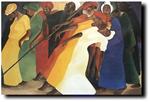
Dancing for the Lord
(Signed Open Edition Lithograph)
Oil on canvas
40" x 60"
|
|
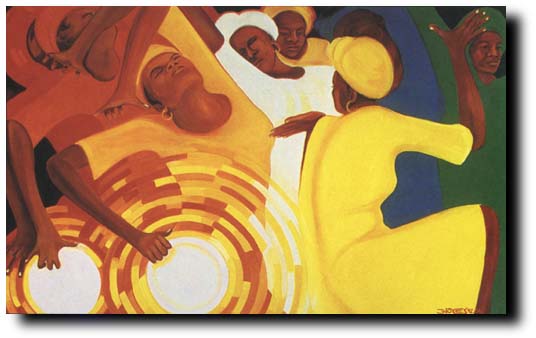
Sanctified Joy
(Signed Open Edition Lithograph)
Oil on canvas
36" x 46"
|
Far more than miles mark the distance between a dimly lit Jamaican backyard and the glitzy streets of Los Angeles. But it is here in a spacious Craftsman just outside LA’s Hancock Park that Bernard Hoyes has made his home. Now 50, the artist has created a name for himself in the Caribbean and - in a more unlikely accomplishment – has carved a position at the pinnacle of the LA art community. In this hyper-competitive market, where artists strive for the cutting edge with the desperation of aging starlets seeking the fountain of youth, Hoyes is somewhat an anomaly, achieving success by faithfully mining the traditions of an old and complex culture, far removed from LA’s tinsel trappings.
|
|
For more than 20 years, Bernard Hoyes has painted in homage to Jamaican revival culture, the "backyard religions", kumina and pocomania, he was exposed to as a child. His Revival Series has brought him wide renown in the Caribbean, earning him honours for capturing the celebration of traditional African religions in contemporary Caribbean life. While his influences were uniquely Jamaican, his work has found universal appeal, selling briskly in the Caribbean and the United States and further abroad in Canada, South America, the United Kingdom, Europe and Australia. Hoyes’ diverse fans are drawn to the colour and energy of his pieces and his lyrical renditions of religious celebrants.
"There is something in his work that seems so alive," says Vera Ennis, curator of the Jamaica Pegasus Gallery, which, with the Bolivar and Mutual Life Galleries, carries Hoyes’ work in Jamaica. "People are drawn to the bright colours and to the sense of movement." Zeneta Kertisz, whose gallery represents Hoyes in LA explains his appeal to an audience completely unfamiliar with his subject matter: "Few artists are able to transfer feeling and spirit to the canvas…. Bernard has a real talent for manifesting and keeping in tact the energy of these ceremonies. The vibrancy and the movement are what attract clients from all races and nationalities. [His work] brings them a great deal of joy."
|
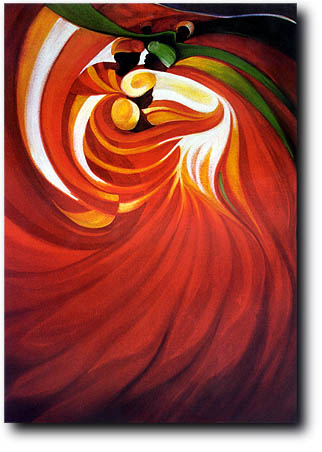
Wheel and Turn
24" x 36"
Oil on Canvas
|
|
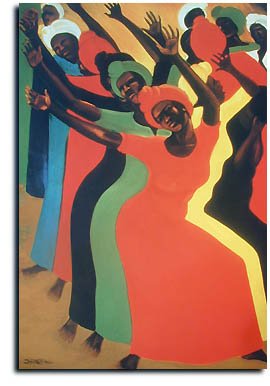
Praising The Most High
(Serigraph Limited Edition of 300)
30"X40"
Original oil on canvas
24"X36"
|
In person, Hoyes is as engaging as one of his paintings; by turns introspective and jocular. He chooses words carefully, with the hesitation of an artist who prefers to communicate in images. His unpretentious home is comfortable and functional, liberally decorated with books, favourite works of art and the toys and trappings of his 18-month old grandson, Anthony. On this summer afternoon, he is preparing to be feted by Grand Performances, a California arts association that has commissioned one of his works for the promotion of their multicultural concert festival. The piece, Block Party, is quintessentially Hoyes; a swirl of colour and movement, dancers and drummers juxtaposed against a city skyline. "We were looking for an artist whose work could capture the energy of what we do and the cultural diversity that is Los Angeles," says Dean Porter, the director of the festival. "Bernard’s work does that - the colours, the rhythm, the energy; the simplicity with which he tells a story."
Bernard Hoyes grew up in the poor community of Rae Town, selling his wooden carvings and paintings to tourists as early as age 9 to help supplement his mother’s income. At 15, he moved to the United States to live with the father with whom his only prior connection had been the backyard services with which his paternal relatives were involved. Though under-prepared for the American school system, Hoyes excelled at art, quickly winning two scholarships to study painting and sculpture at the Vermont Academy. Thanks to the weak legs of a few older soccer pals, he declined a soccer scholarship to study at Princeton, opting instead for the California College of Arts and Crafts in San Francisco. "I actually thought about being a soccer player and I worked really hard at it," jokes Hoyes. "But I looked at the old guys and I could see there wasn’t a future. Plus I knew a whole lot of soccer players who were better than me, but not too many artists who could draw better than I could."
|
|
After receiving his B.F.A. in 1975, he moved on to Los Angeles to seek fame and fortune. Quickly frustrated by the vacuity of the LA art scene, he began making regular trips to Jamaica in search of inspiration. The move was risky, given the limited market for ethnic material in Los Angeles at the time. Yet Hoyes was determined to build his career on something to which he could feel a real connection. "I realized that my art had to reflect where I was coming from," he explains. "I had to find something in my past that had a universality I could communicate to a national and international audience."
|
.jpg)
Moonlight Spiritual
(Signed & Numbered Limited Edition of 500)
22"x32"
|
|
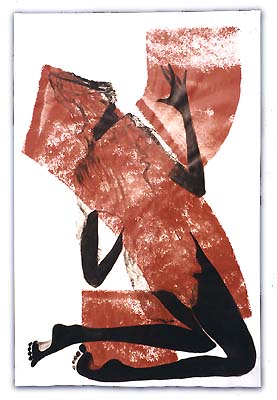
One Percent Rag
24" x 36"
Ink on Paper
|
His first attempts resulted in the Rag Series, a gritty exploration of urban and Black Nationalist themes that later evolved into musings on poverty, racial consciousness and cultural development. Though well received, the series left Hoyes feeling unfulfilled. He went home again, this time shifting from the political to the spiritual influences that had been a large part of his childhood. "I wanted to bring people together, not divide them," he says. "I wanted to find something that could be a rallying cry. I believe that the spiritual connection is the strongest connection we have. It overcomes everything else that divides us."
|
|
Unable to shake his childhood memory of the backyard services, Hoyes began the Revival Series. He aimed to document a dying religion, but also to capture the emotional and spiritual nuances that coloured his perceptions as a child. "I remembered how frightened I was, but in that fear I perceived power," he explains. "I wanted to understand that power, to capture it." He went back to Jamaica, attending more services and delving further into the history and traditions of the religions. Retreating to the tiny Two Sisters cottage in Port Henderson in 1981, he painted at a feverish pace for three months, producing forty paintings that were the genesis of the Revival Series. Twenty years later, he continues to work on the series with the energy and enthusiasm that drove those first months.
|
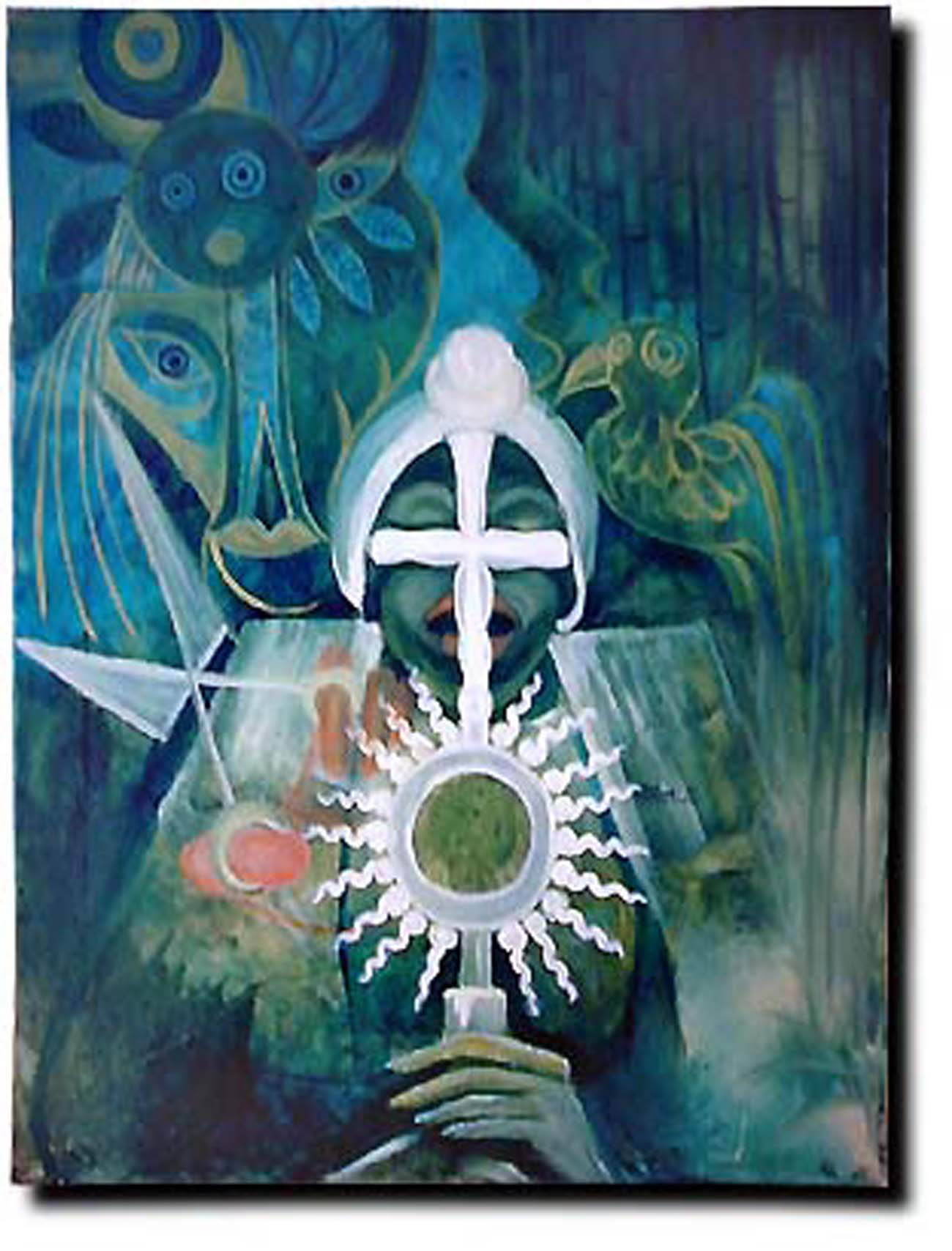
A Secret Place
18" x 24"
Oil on Canvas
|
|
"
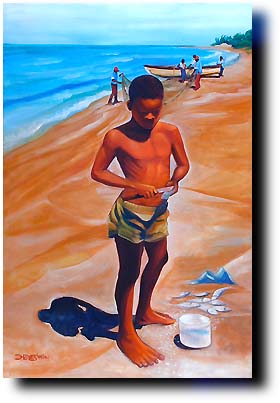
Ceremony of the Catch
1999
24" x 36"
Oil on Canvas
|
Every painter has to find a subject matter that propels your imagination and energy; something that motivates you and keeps you agile," says Hoyes, explaining his long passion for the subject that has defined his career. "You have to be engaged cerebrally, or painting becomes a boring exercise. As an artist you have to believe in what you’re doing and follow it through for as long as it motivates you." While Hoyes also paints depictions of other facets of Caribbean life – the village scenes and seaside vendors he first painted as a child – the Revival Series has proved to be his mainstay, the truest reflection of his artistic vision and the work that has earned him a place in the homes of notable collectors such as Oprah Winfrey, Natalie Cole and Richard Pryor.
Over twenty years, the series has taken on a life of its own, driving evolutions in Hoyes’ artistic style as he tries to capture different elements of the religion and culture. While his early work in the series emphasized primary colours, implied lines and full plane compositions, the later pieces have grown more complex. Stylistically, the lines and tonalities have grown more intricate. Thematically, the series has matured beyond depictions of worshippers to tell the broader story of the religion - the spiritual and physical manifestations of the deities, the myths, folklore and rituals.
|
|
Hoyes is little concerned that the evolution of the series may risk the favour of his loyal fans. In the acclaim he has found at home and abroad, he finds vindication for staying true to his vision and support for the potential of other Caribbean artists to achieve international success by exploring and representing their own cultural heritage. "This isn’t about the art market," he says. "This is about reclamation. Sometimes you have to follow your vision and see where it takes you. I don’t plan my work; I just follow it around."
|
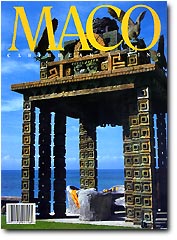
Bernard Hoyes
|
| |
| | |
|
|
|